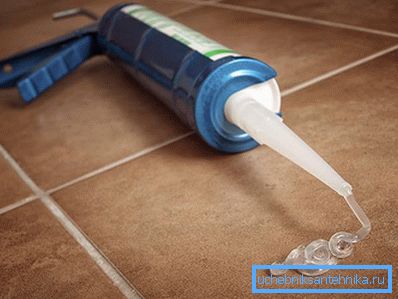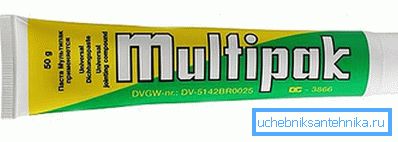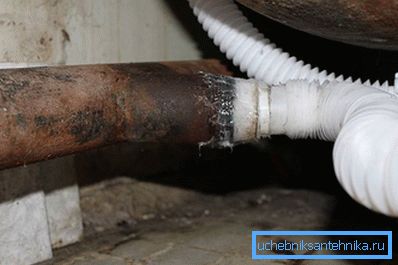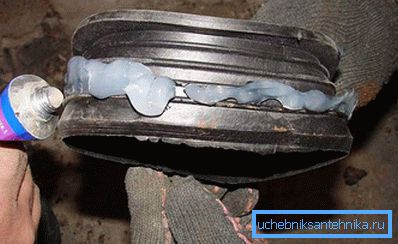Sealing sewer pipes: how to choose
Operation of the pipeline, made of a particular material, suggests the possibility of leakage in the place where the individual elements of the pipeline are interconnected. Therefore, it is necessary to carefully approach the question of sealing the sewer pipe, especially if we are talking about joining highways made of different materials or inserting a separate branch that does not allow using standard fittings. This section of the pipeline is considered the most problematic, since the solution to the problem differs both in price and operation time. Sealant for PVC pipes is an adhesive, the main purpose of which is to connect the communications and ensure the tightness of the fittings of pipes.
Why do you need sealing

So, what is the need for sealing:
- to prevent leakage, which can lead, for example, a strong pressure flow;
- to protect the compounds from possible temperature differences of both the environment and water in the pipe;
- to protect the nozzle from exposure to water or any other liquid, such as groundwater or precipitation.
By sealing the sewer pipe, both internal and external strength of the connection of the nozzle is provided. In addition, sealants are needed for designs of polyvinyl chloride. It is with the help of this tool that the inserted pipeline is fastened to the socket and the joints of the rubber cuff are sealed. The latter is not able to ensure complete tightness of the sewer pipe, so one cannot do without silicone sealant, which not only prevents the possible appearance of damage, but also increases the service life of the cuff.
Silicone sealant

The basis of silicone sealant for sewage is rubber. In addition, this material includes many different substances that provide high quality indicators. Silicone sealants have the following advantages: good adhesion to the surface, as well as no need for pre-treatment with primers.
If the assessment is based on the type of hardener that is part of the silicone sealant, we can distinguish the following types:
- Acid silicone sealant is affordable, but cannot be applied to surfaces that cannot interact with acids;
- neutral is more versatile than the previous one.

Sanitary sealant allows isolation of sewer pipes, made of:
- from metal;
- from plastic.
Vulcanization of a paste of silicone leads to the fact that the substance in its properties begins to resemble rubber.
Tip! For extrusion is best to use a mounting gun. If one is not at hand, an ordinary hammer is useful - you need to insert a handle into the tube and press it like a piston.
About the benefits

Distinctive features of the silicone material is:
- high resistance to ultraviolet radiation;
- ability to withstand any natural conditions;
- excellent adhesion with any sanitary design;
- wide admissible temperature from -50 to +200? C;
- it is allowed to put both on a cold, and on a hot surface;
- the composition contains a fungicide, which is why sanitary sealant prevents the development of mold.
The following quality criteria are characteristic of a waterproof sealant:
- good adhesion with any type of material;
- the drying process is completed by the appearance of a smooth shiny surface;
- strength is maintained when there is the next temperature range - from -50 to + 150? C;
- resistant to any aggressive chemical element that fell on the seam while washing the bathroom;
- high values of elasticity, without which it is impossible to fix the moving parts.
Terms of use

Before sealing the plumbing pipes, you need to figure out how to properly use the sealant, otherwise it will lose elasticity and crack.
The correct sequence of applying sealant:
- First you need to prepare the surface - to rid it of dirt and rust, and then sand and degrease.
- Now you can proceed to sealing. It is recommended to insert the cartridge with the substance into the mounting gun. After that, you need to pull the trigger and proceed to the processing of the seam. Ideally, the line should be applied continuously. If the sealant gets to the unwanted area, it must be removed with a napkin or a damp cloth.
- As soon as it takes 5 minutes after application, you can begin to form a seam. This procedure can be performed with hands in rubber gloves or a spatula, pre-moistened with water. Contact between bare hands and sealant can damage the skin, as there is acid in the composition.
- It is best to use paper to remove excess material. And if a lot of time has passed, then a special solvent will help to get rid of unwanted layers.
- It is necessary to complete the editing of the joints within 20 minutes, as this time is enough for the silicone sealant to set.

Some additional recommendations:
- the width of the seam should vary from 5 to 30 mm;
- the depth of the layer should be 2 times the width;
- if deep seam formation is planned, then sealing tape will be required;
- Silicone composition is not very well combined with materials such as: brass, copper, synthetics and lead. This duet can lead to the release of substances harmful to the human body.
What else can seal sewer pipes

Insulation of sewage pipes in an apartment can also be done by other means:
- Epoxy - the most popular means for use in the home.
- Portland cement is a fairly common component that is part of almost every sealing mixture. The main field of application is the preparation of a mixture of asbestos cement and a caulking of the socket of a cast iron sewer pipe.
- Technical sulfur. Ensures the tightness of the joints of the sockets of cast-iron sewer pipes. Before use should be thoroughly crushed and heated to the melting temperature.
- Oil bitumen or asphalt mastic. From these components should be prepared fill, with which in the future will be made sealing joints and pouring the sockets of the ceramic pipeline.
- Hemp or jute rope, resin yarn. It is suitable for sealing the socket of cast iron and ceramic sewer pipes. It is best to connect the rope and resin impregnation.
In general, the modern market is ready to offer a variety of sealing materials, the main thing is not to be mistaken with the choice of the most suitable one.
Video
See how to apply sealant to PVC sewer pipes:
This video shows how to seal the joints in a cast iron sewer: